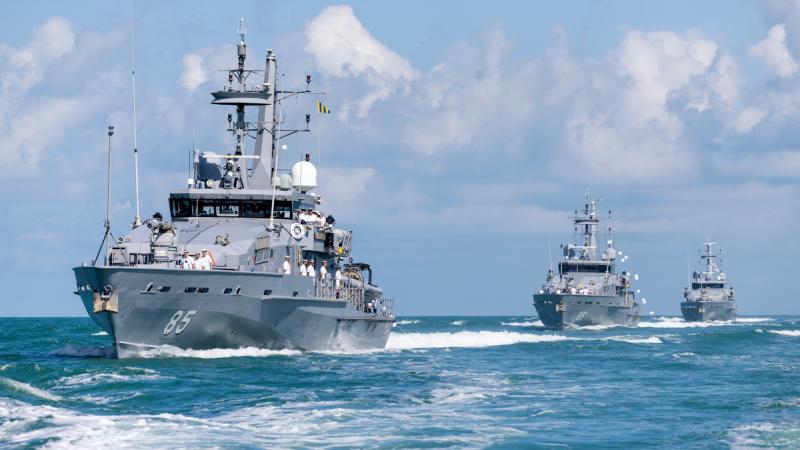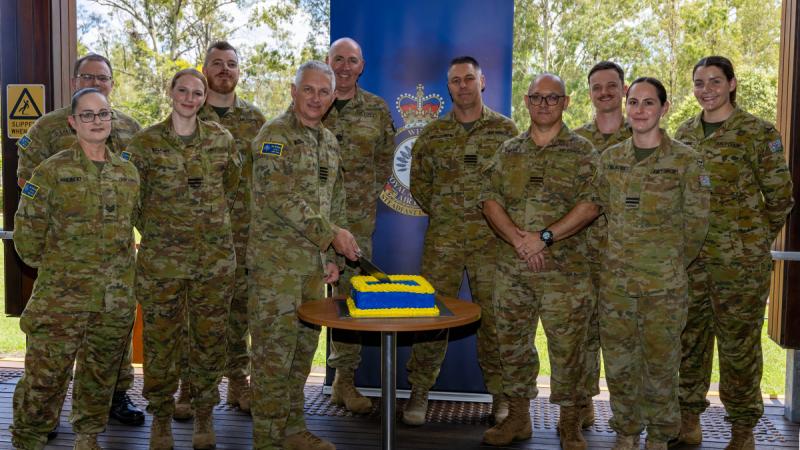8 August 2025
Royal Australian Navy sailors and officers have taken part in the 17th Sea Rights anniversary on the shores of Blue Mud Bay at Bäniyala, Northern Territory.
Navy personnel took part in a week of cultural immersion leading up to the anniversary, conducting activities with local members of the community.
Deputy Chief of Navy Rear Admiral Matthew Buckley and other Navy representatives attended the anniversary on July 30.
Each year, Navy’s leaders visit the Bäniyala community, home to about 150 Yolŋu people, to celebrate the signing of the 2008 Blue Mud Bay High Court decision on traditional ownership.
That decision confirmed that traditional owners of Aboriginal-owned NT coastline have exclusive access rights to the tidal waters overlying their land.
It established an important legal precedent for sea rights in Australia.
The people of the Bäniyala community were key players in the Blue Mud Bay case.
Sea country is very important to Aboriginal people. Sacred sites and songlines in the sea carry the same cultural importance as those on land.
The tidal waters and broader seas are important to the livelihoods of Aboriginal people living in remote coastal communities.
Rear Admiral Buckley met with Elders from the community, including Djambawa Marawili.
Dr Marawili is a senior Yolŋu Elder, traditional owner and internationally renowned artist who has been central to the Sea Rights movement.
“It is a tremendous honour for the Navy to be invited to take part in another Sea Rights anniversary at Bäniyala,” Rear Admiral Buckley said.
“Our presence here strengthens the shared connection to the sea we have with First Australians, in the spirit of Sea Rights.”
'In a broader sense, the Navy’s involvement here highlights our role in both protecting our physical borders as well as preserving Australia’s culture and identity.'
To commemorate the anniversary, a ceremony was held at the Sea Rights Yingapuyŋapu, a permanent sand sculpture memorial located on the Bäniyala foreshore.
It is a cultural space used for reflection, knowledge sharing and peacemaking.
Ceremonies and special occasions, such as the anniversary, renew the memorial in a physical and cultural sense.
At the invitation of Dr Marawili, all attending Yolŋu leaders and allies placed their spears alongside his at the centre of the Sea Rights Yingapuyŋapu, with each spear representing individual Yolŋu clans.
Their unification signified a powerful cultural demonstration of solidarity and shared intent.
This year, Navy had the great honour of joining the spear ceremony with its own contribution of a ship’s anchor.
Navy chose a ship’s anchor as a symbol of hope, strength and security, stemming from its maritime function of holding a ship in place.
It also represents steadfastness and a safe harbour in the face of adversity.
Navy Indigenous Adviser Commander Michael Henry highlighted the significance of the event.
“Unveiling the anchor was a powerful acknowledgement of the values we share with the Yolŋu people and affirms our ongoing commitment to the spirit of Sea Rights,” Commander Henry said.
“In a broader sense, the Navy’s involvement here highlights our role in both protecting our physical borders as well as preserving Australia’s culture and identity.”
The strong engagement between the Navy and Sea Rights initiatives was reinforced in 2024 with the commitment by the Navy to develop a Saltwater Leadership Program in late September 2025.
The aim of the program, which has been co-designed with the local community, is to build an enduring relationship between Navy and First Nations peoples.
Combined teams of Navy personnel and local community members will take on a leadership task, which will be an immersive experience, mixing different cultural backgrounds.


